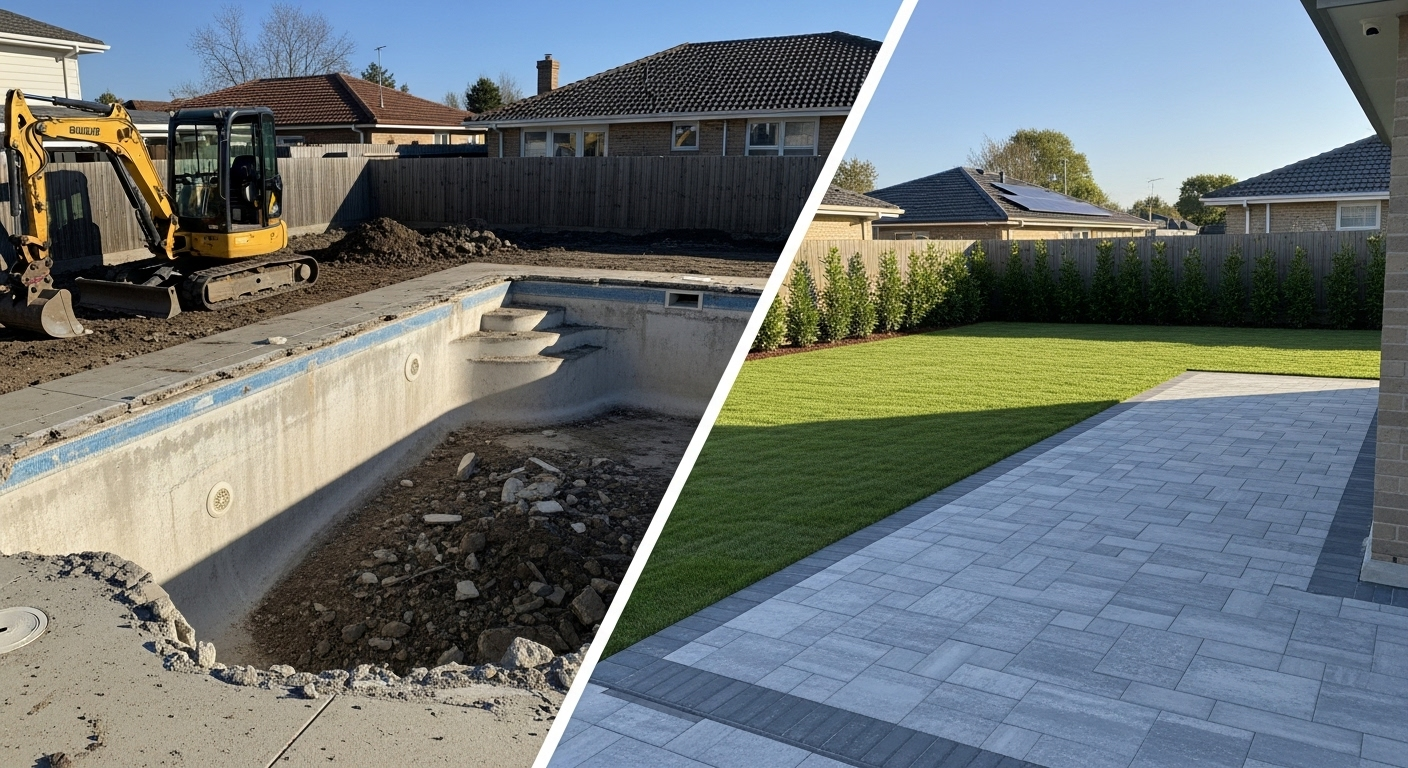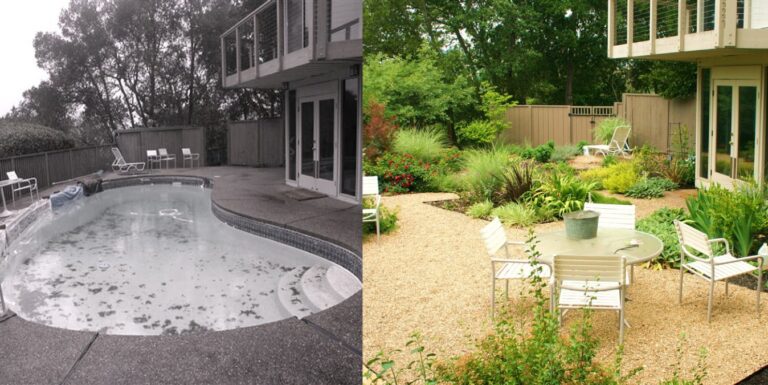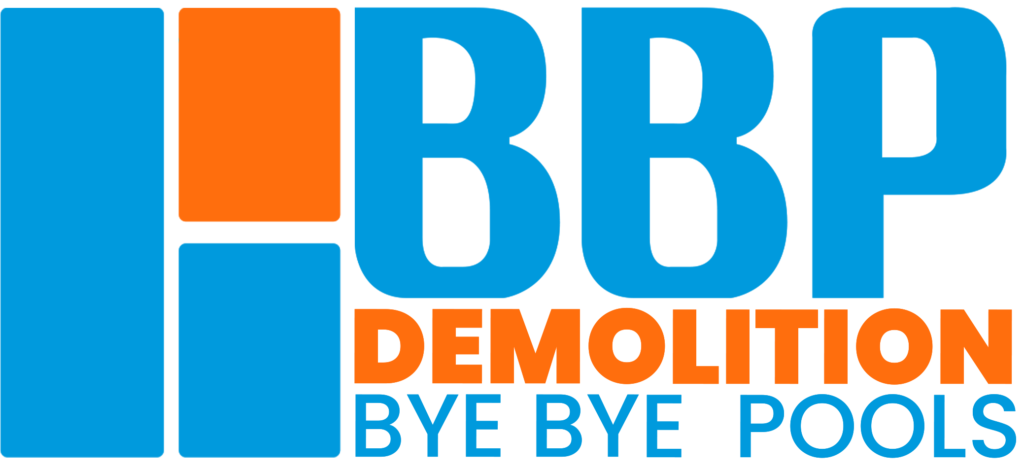Decisive Guide: 5 Pros & Cons of Partial vs Full Pool Removal
Considering removing your swimming pool but feeling overwhelmed by the options? You’re not alone. Many homeowners face the crucial decision between different methods, and understanding the nuances of partial vs full pool removal is essential for making the right choice for your property and future plans. This comprehensive guide will clearly explain both approaches, detailing their processes, costs, and long-term implications. By the end, you’ll have a complete grasp of the pros and cons of partial vs full pool removal, empowering you to decide confidently and avoid costly mistakes. Ready to simplify your pool removal journey? Let’s break down the differences!
Why Is Pool Removal Even an Option? A Quick Look
Before we dive into the specifics of partial vs full pool removal, let’s briefly touch upon why homeowners choose to remove their pools in the first place. The motivations are varied but often revolve around financial relief, safety concerns, and the desire for more functional outdoor space.
The Growing Trend of Pool Demolition
In recent years, pool removal has become an increasingly popular option. Factors contributing to this trend include:
- High Maintenance Costs: The ongoing expenses for water, chemicals, electricity for pumps, and repairs can be substantial.
- Underutilization: Many pools simply aren’t used as much as anticipated, becoming expensive, unused features.
- Safety Concerns: For families with young children or pets, an unattended pool can be a significant liability.
- Desire for More Usable Space: Homeowners often wish to reclaim their backyard for gardens, patios, outdoor kitchens, or even future home expansions.
Understanding these underlying reasons highlights why homeowners need to weigh their options carefully, particularly when considering partial vs full pool removal.
Partial Pool Removal: The “Fill-In” Method Explained
Partial pool removal, often referred to as “backfill,” “dirt-in,” or “fill-in” removal, is a method where only a portion of the pool structure is removed before the cavity is filled. This approach is generally quicker and more affordable upfront.
The Process of Partial Pool Removal: What Happens?
- Water Drainage: First, the pool is completely drained. This water must be properly dechlorinated and discharged according to local regulations (often into the sanitary sewer system, never storm drains).
- Top Demolition: The top 18-36 inches (approx. 0.5 to 1 meter) of the pool walls and any surrounding decking are broken down. This involves heavy machinery like jackhammers and excavators.
- Holes in the Bottom: Crucially, strategic holes are punched through the bottom of the remaining pool shell. These “kindergarten holes” or drainage holes are vital to allow water to percolate through the soil, preventing the remaining pool shell from holding water like a giant subterranean bathtub, which could lead to future settlement issues or water accumulation.
- Debris Backfilling: The concrete debris generated from the top demolition (and sometimes additional clean fill) is then strategically placed into the bottom of the pool cavity. This debris helps with drainage and reduces the amount of new fill material needed.
- Backfilling and Compaction: The rest of the pool cavity is filled with clean, engineered fill material. This material is added in layers (typically 8-12 inches at a time) and meticulously compacted using specialized vibratory compactors. Proper compaction is essential to prevent future settling of the ground.
- Final Grading: The area is then graded to ensure proper drainage away from your home and prepared for new landscaping.
Pros of Partial Pool Removal: Is It the Right Fit for You?
- Lower Upfront Cost: This is the primary advantage. Less material is hauled away, and less extensive demolition is required, making the initial expense significantly lower than full removal.
- Quicker Completion: With less material to remove and dispose of, partial pool removal can often be completed in a shorter timeframe.
- Less Invasive to Surrounding Landscape: Generally, less heavy equipment traffic is needed, potentially causing less disruption to existing landscaping around the pool area.
Cons of Partial Pool Removal: Understanding the Limitations
- Disclosure Requirements: You are legally obligated to disclose a partial pool fill to any future buyers of your property. This can complicate sales and potentially deter some buyers.
- Limited Future Use of Space: You generally cannot build permanent or heavy structures (like a new home addition, an ADU, or even a large shed with a concrete foundation) over a partially filled pool area. The risk of future settlement, even with proper compaction, makes it unsuitable for such construction.
- Potential for Future Settlement: While professionals compact meticulously, the risk of some long-term settlement remains higher than with a full removal, potentially leading to depressions or uneven ground over time.
- Drainage Issues: If the drainage holes aren’t sufficient or if improper fill material is used, water can still accumulate in the buried shell, leading to issues like saturated soil, pest problems, or even structural damage to nearby foundations.
- Less Appeal to Buyers: Some buyers may view a partial fill negatively, fearing unknown future issues or simply preferring a completely clear property history.
When is Partial Pool Removal a good option? This method is typically chosen when cost is the overriding factor, and the homeowner plans to use the reclaimed space for light landscaping, a garden, a lawn, or an unattached patio area. It’s crucial to understand the implications for future property use.
Full Pool Removal: The “Complete Demolition” Method Explained
Full pool removal, also known as “complete demolition,” involves breaking up and hauling away the entire pool structure, including the shell, decking, and any associated rebar or plumbing. The excavated area is then completely refilled with clean, engineered material.
The Process of Full Pool Removal: What to Expect
- Water Drainage: Similar to partial removal, the pool is completely drained, dechlorinated, and water is disposed of according to local regulations.
- Complete Demolition: Heavy machinery, such as large excavators equipped with powerful hydraulic hammers, systematically breaks down the entire pool shell, bond beam, rebar, and all surrounding concrete decking. Every piece of the old pool structure is reduced to manageable debris.
- Debris Hauling: All demolished materials—concrete, rebar, plumbing lines, filter equipment—are loaded into large dump trucks and hauled off-site for disposal and, ideally, recycling.
- Backfilling and Compaction: The entire excavated cavity is then filled with clean, engineered fill material. This material is placed in thin layers (usually 8-12 inches), and each layer is thoroughly compacted using heavy vibratory compaction equipment. This process ensures maximum density and stability. This is the most critical step to prevent future settlement.
- Final Grading: The site is meticulously graded to ensure proper surface drainage away from your home’s foundation and is left level, ready for any new construction or landscaping project.
Pros of Full Pool Removal: The Long-Term Advantages
- No Disclosure Required: Since the pool is completely gone, there’s no need to disclose a buried structure to future buyers, simplifying property sales.
- Unlimited Future Use of Space: The ground is considered virgin earth. You can build any structure—a new home addition, an ADU, a garage, or a large patio with a solid foundation—over the area without concerns about future settlement.
- Maximum Stability: Proper backfilling and compaction of the entire cavity significantly reduce the risk of future ground settlement, providing the most stable foundation for any subsequent landscaping or construction.
- Enhanced Buyer Confidence: Buyers often prefer a complete removal, as it eliminates any potential unknown issues associated with a buried pool, making your property more attractive and potentially increasing its value.
- Peace of Mind: Knowing the entire structure is gone provides complete peace of mind, eliminating any lingering thoughts of buried issues.
Cons of Full Pool Removal: The Downside Considerations
- Higher Upfront Cost: This is the main drawback. More extensive demolition, a greater volume of debris to haul away, and a larger quantity of engineered fill material make full removal more expensive than partial removal. Costs can easily be double or more.
- Longer Project Duration: The more thorough process typically means the project will take longer to complete, ranging from several days to over a week, depending on pool size and site conditions.
- More Invasive: The use of larger equipment and the need to access all parts of the pool for complete removal can be more disruptive to existing landscaping around the pool area.
When is Full Pool Removal the best option? Full removal is the recommended choice if you plan to build any type of structure over the former pool area, want maximum peace of mind regarding future settlement, or wish to maximize your property’s appeal to the broadest range of buyers without any disclosure complexities.
Image Placeholder 1: A powerful side-by-side comparison. On the left, a large excavator is shown actively dismantling an entire concrete pool, with the empty excavation pit clearly visible. On the right, the same area is now a completely level, freshly compacted and graded patch of earth, indicating total removal and readiness for new construction. The background shows a typical suburban home in Concord, CA, emphasizing the completeness of the transformation.
Key Factors Influencing Your Choice of Partial vs Full Pool Removal
Beyond the basic pros and cons, several practical considerations will heavily influence your decision between partial vs full pool removal.
1. Your Budget: How Much Can You Comfortably Spend?
- Partial Removal: Offers significant upfront savings, making it attractive if cost is your primary constraint.
- Full Removal: Requires a larger initial investment, but often provides greater long-term value and flexibility. Consider if the extra cost now saves you potential headaches or limitations later.
2. Future Plans for the Space: What Do You Envision?
- Light Use (Garden, Lawn, Patio): Partial removal can suffice if you only plan light landscaping.
- New Construction (ADU, Addition, Garage): Full removal is almost always necessary to ensure a stable foundation for any new structures. This is a non-negotiable factor when deciding between partial vs full pool removal.
- Resale Value Impact: If selling your home in the near future, consider how potential buyers in your market (e.g., Concord, CA) perceive partial vs. full removal. Many prefer the complete removal.
3. Local Regulations and Permits: Don’t Get Caught Off Guard!
- Permit Requirements: Both partial and full pool removal typically require permits from your local municipality (e.g., City of Concord building department). Always ensure your contractor handles this.
- Disclosure Laws: Understand California’s disclosure laws regarding buried structures. Partial fills must be disclosed. While full removals technically don’t require disclosure of the former pool, knowing its history can be helpful. Your chosen professional should be well-versed in these local nuances, particularly when discussing partial vs full pool removal.
- Backfill Standards: Some municipalities have stricter requirements for fill materials and compaction, especially for full removals.
4. Property Access: How Easy Is It to Work?
- Wide Access: If you have wide gates and clear paths for heavy machinery, full removal becomes more feasible and cost-effective.
- Limited Access: Narrow access points might complicate full removal, potentially increasing costs due to the need for smaller equipment or more manual labor. In such cases, the logistical ease of partial removal might seem more appealing, though the long-term implications remain.
5. Type and Condition of Your Pool: Material Matters
- Concrete Pools: Being robust, concrete pools are harder to demolish entirely, increasing the cost for full removal. However, their structural integrity means a partial fill, if done correctly, can be stable for non-structural use.
- Fiberglass/Vinyl Pools: These are generally easier and less costly to remove fully compared to concrete, potentially narrowing the price gap between partial vs full pool removal for these types.
The Professional Advantage: Why Expertise Matters for Partial vs Full Pool Removal
Regardless of whether you choose partial vs full pool removal, partnering with an experienced and reputable professional contractor is paramount. DIY pool removal, or hiring an inexperienced company, can lead to serious and costly long-term issues.
What a Professional Pool Removal Company Offers
- Expert Assessment: They’ll evaluate your specific pool, property access, and local regulations to recommend the best removal method for your needs and budget. This initial assessment is key when weighing partial vs full pool removal.
- Permit Handling: Professionals manage all necessary permits, ensuring compliance and preventing legal headaches.
- Specialized Equipment: They have the right heavy machinery for efficient demolition, debris hauling, and, critically, proper compaction.
- Proper Backfilling & Compaction: This cannot be overstressed. Professionals use engineered fill and layered compaction techniques to prevent future settlement, which is vital for the long-term integrity of your property. Improper compaction is a common and expensive mistake in DIY or unskilled removals.
- Responsible Waste Disposal: Licensed contractors ensure debris is disposed of legally and, whenever possible, recycled, minimizing environmental impact.
- Insurance & Safety: They carry the necessary insurance to protect themselves, their workers, and your property in case of accidents. They also adhere to strict safety protocols.
At Bye Bye Pools, we have extensive experience in both partial vs full pool removal methods across Concord, CA, and surrounding areas. Our expertise ensures a smooth, safe, and efficient project from start to finish. Our services are fully licensed (Lic: 1076976) and insured, providing you with complete peace of mind. Learn more about our detailed process and commitment to quality at https://byebyepools.com/about-pool-removal-services-experts/.
Hear From Our Satisfied Clients:
“We were torn between partial vs full pool removal due to budget, but Bye Bye Pools explained all the pros and cons clearly. We went with a partial, and they did an excellent job, really professional.” – Chris T., Concord, CA (Google My Business Review)
“Bye Bye Pools are very friendly and have awesome customer service. They remove and demolish old pools and make sure you have the perfect area for whatever you would like to build next!” – Jose G. (Yelp Review)
“From the first phone call to the very last meeting, every Bye Bye Pools representative has been professional, friendly and courteous. They helped us understand the differences between partial vs full pool removal for our property, and we’re thrilled with the outcome.” – Emily R. (Yelp Review)
You can find more glowing reviews on our Yelp page: https://www.yelp.com/biz/bye-bye-pool-concord. Our office is located at 4918 Clayton Rd Concord, CA 94521, and you can locate us on Google Maps here
Beyond the Demolition: Transforming Your New Space
Once your pool is gone, regardless of whether you chose partial vs full pool removal, the real fun begins: transforming your reclaimed backyard. The possibilities are endless, and you can significantly enhance your property’s value and usability.
Creative Ideas for Your Reclaimed Space:
- Outdoor Living Areas: Design stunning patios using durable Patio Pavers or custom-built Pergolas for shade. Add an inviting Outdoor Kitchen & BBQ Island or a cozy Fire Pit for year-round enjoyment.
- Lush Landscapes: Install drought-tolerant gardens, or opt for low-maintenance, water-saving Artificial Turf for a perpetually green lawn.
- Functional Features: Consider elegant Walkways Pavers, decorative Walls and Pillars, or essential Retaining Walls for sloped areas. Enhance safety and ambiance with expert Outdoor Lighting.
- Privacy & Security: A new Wood Fence can complete the transformation.
Our trusted partners at BBP Pavers specialize in these and many other outdoor living enhancements. Visit their website at https://bbppavers.com/ to explore how they can help you bring your vision to life after your partial vs full pool removal.
Image Placeholder 2: A split image. On the left, a partially demolished pool with debris being pushed into the hole, showing the “dirt-in” process. On the right, a fully demolished pool site, completely leveled and ready for new construction, with a new foundation being laid or a large, clear space visible.
Making the Right Pool Removal Decision for Your Home
The choice between partial vs full pool removal is a significant one, impacting your budget, property’s future use, and long-term value. While partial removal offers a lower initial cost, it comes with disclosure requirements and limitations on future construction. Full removal, though a larger upfront investment, provides complete peace of mind, maximum stability, and unrestricted possibilities for your transformed backyard.
Ultimately, the “best” option depends on your specific needs, budget, and plans for your property. However, one constant remains: professional execution is non-negotiable for a successful and lasting result, regardless of whether you choose partial vs full pool removal.
Ready to discuss your pool removal options and get a tailored estimate?
Contact Bye Bye Pools today for a free, no-obligation consultation! Our experienced team will assess your property, explain the nuances of partial vs full pool removal in detail, and help you make the smartest choice for your home in Concord, CA.
- Call us now: (925) 940-9978
- Email us: byebyepool.com@gmail.com
- Visit our website: https://byebyepools.com/contact-us/
Let’s turn your old pool into a valuable asset!






